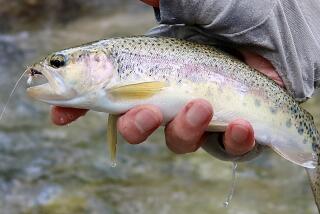Professor Baby-Sitting Sticklebacks Till Their Creek Rises
- Share via
University of Redlands biology professor James Malcolm is baby-sitting 200 endangered sticklebacks rescued last month when their natural habitat in San Bernardino County began to dry up.
Malcolm, 33, who studies stickleback behavior, discovered last year that there were unarmored threespine sticklebacks in Shay Creek, which flows into Baldwin Lake. But when he visited the creek this summer, he found a stickleback disaster in progress.
“When I got up there in late July, most of the creek had dried up, and there were lots of dead sticklebacks sticking out of the mud,” he said.
Malcolm called federal and state wildlife authorities, including the Stickleback Recovery Team. The team recommended collecting as many fish as possible in hopes of keeping them alive until the water level of the creek rises and they can be released again in the wild.
As a result, 200 are living in seven aquariums in the university’s biology department, eating worms from a pet store. They are spread out to maximize their chances of surviving disease or tank disaster.
Malcolm emphasized that even if the fish breed in captivity, “we’re not going to save the species of this earth by captive propagation.”
“The conditions in my tanks are radically different from the conditions in Shay Creek,” he said. “Because the environment is so different, the ones that breed in captivity aren’t necessarily the ones that would breed in the wild, and so the genetic composition of the group would probably change.”
It is possible, although difficult, to maintain genetic diversity--that is, to avoid inbreeding--in a group such as this, given that there are more than 50 individuals, he said.
Malcolm hopes that the fish can be returned home in November. Preservation of their natural habitat is still the best way to preserve species, he said. Meanwhile, he hopes that living in campus fish tanks will not do the creatures too much harm. “Growing up in captivity they may be missing something that would make them effective adult sticklebacks,” he fretted.
Although the majority of the remaining unarmored threespine sticklebacks are in the Santa Clara River, a few also apparently survive in San Francisquito Creek, a tributary of the Santa Clara, and in Shay Creek.
There are also plateless sticklebacks in San Antonio Creek on Vandenberg Air Force Base, 55 miles north of Santa Barbara. However, recent genetic tests by UCLA biologist Donald Buth suggest that the Vandenberg fish only look like unarmored threespine sticklebacks. Instead of being twins of the protected Santa Clara fish, they may actually be cousins, members of a different, partially armored subspecies that have somehow lost their plates.
More to Read
Sign up for Essential California
The most important California stories and recommendations in your inbox every morning.
You may occasionally receive promotional content from the Los Angeles Times.










